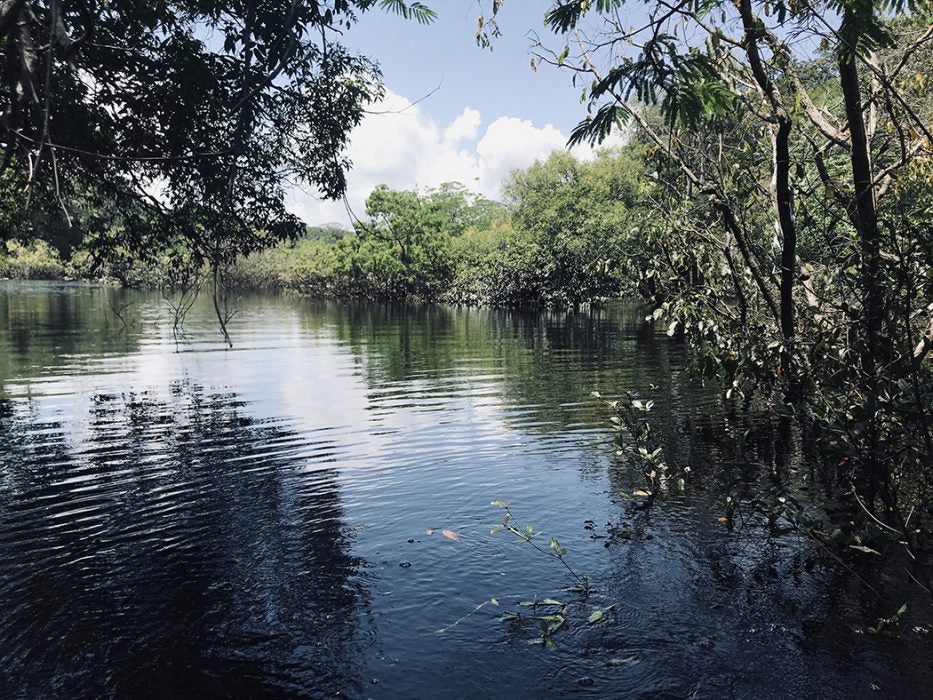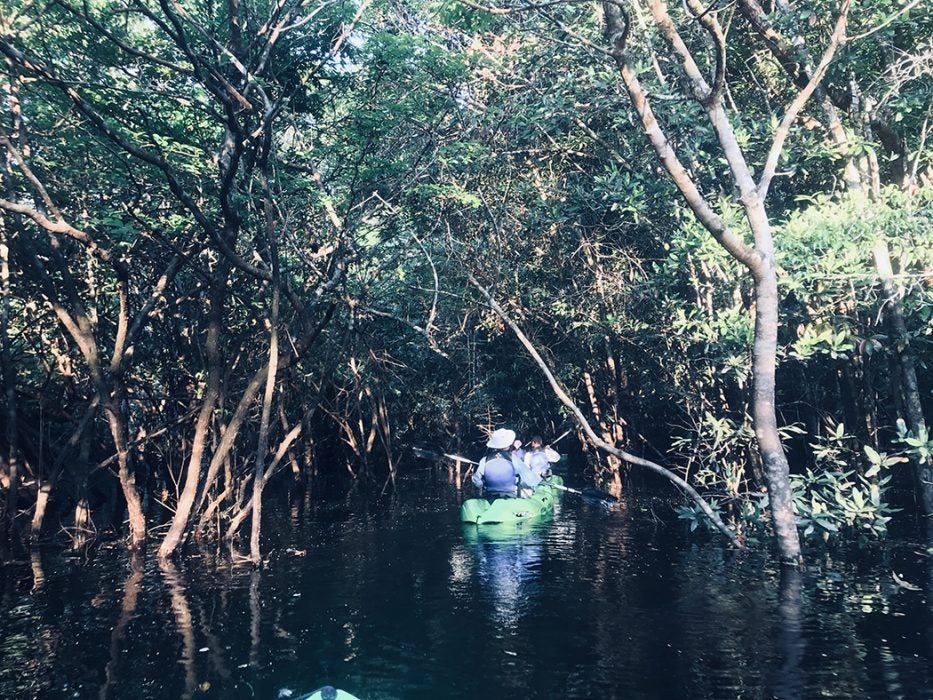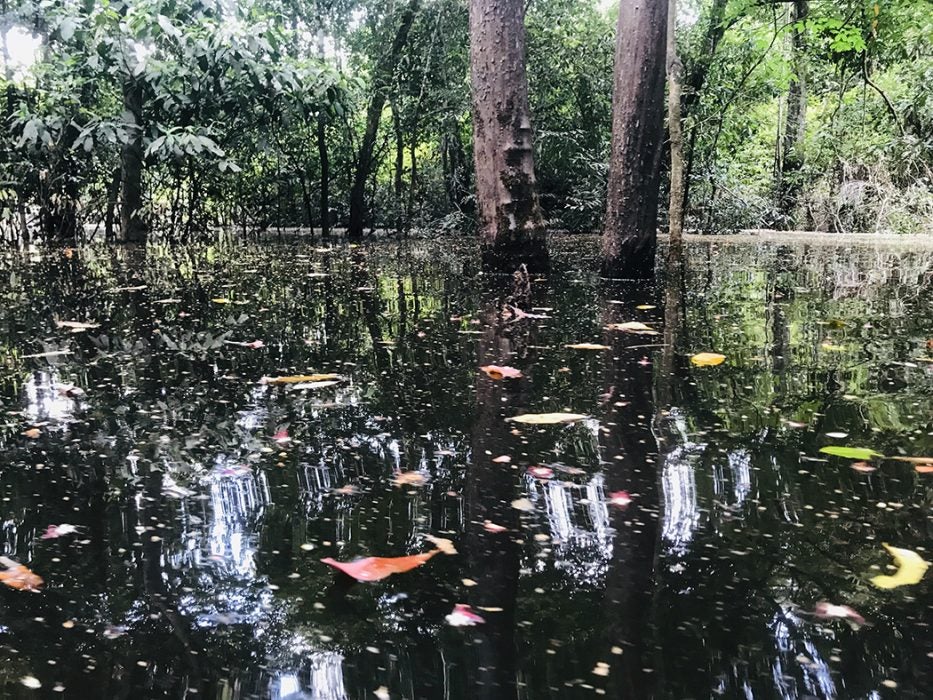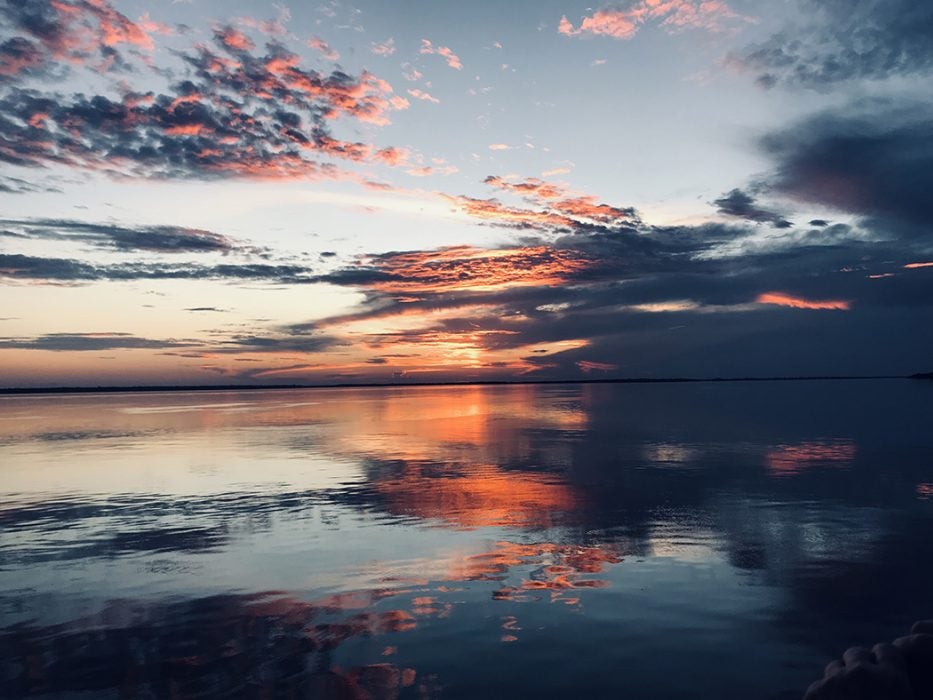A triple-decker boat slowly glides through the calm currents of Rio Negro, an Amazon River tributary and one of the most pristine and diverse ecosystems on earth. In good weather, Rio Negro’s waters are so still that when the boat stops moving its mirror image rests on the river surface undisturbed. When small, motorized launches sail away from the ship to explore the rainforest and its inhabitants, the water quivers ever so slightly—and then becomes quiet once again.
Named Tucano, after one of Amazonia’s countless native birds, the vessel is the brainchild of American boat builder and rainforest evangelist, Mark Baker, who brings small groups of eco-minded travellers to marvel at Rio Negro’s untouched beauty and learn about the science behind it. Tucano’s two guides, who lead rainforest hikes and kayak explorations, come from Brazil’s native communities. They can mimic birdcalls, spot sloths hanging upside down within the dense foliage, and smell howler monkeys when they come close.
Unlike the Amazon River, known for its opaque brown currents, Rio Negro, which means Black River in Portuguese, earned its name for its shiny-black mirror-like surface. “The water is like tea brewed from the forest leaves,” says Giordane Martins, who studies plant phenology, forest ecology, and how trees affect the atmosphere at the National Institute of Amazonian Research in Manaus, Brazil. “It’s black because the rainwater that feeds it passes through many leaves on the forest ground on its way to the river.” The tannins and other organic compounds from leaves and roots make Rio Negro’s water acidic, which kills certain microorganisms. The plants also siphon nutrients out of the water. The acidity and nutrient scarcity have an unexpectedly positive effect for human visitors—there are noticeably fewer mosquitoes because the acid destroys the larvae. Known as igapó, or black-water flooded forest, Rio Negro’s unique ecosystem has adapted to seasonal water fluxes. The tall, magnificent trees and palms have evolved massive roots to thrive in both floods and low-water seasons, while harboring hundreds of species of plants, birds, and land animals.
The igapó is peaceful. It is far from the fires raging in several parts of Brazil. Mere miles away, however, 100-year-old Amazonian trees are burning as a result of land clearing for agriculture, shrouding the rainforest in black smoke. These fires set the world ablaze, too. When the Group Seven countries pledged a $20 million help package to fight the wildfires, Brazil’s president Jair Bolsonaro rejected the offers, accusing heads of state of treating Brazil like a colony, in some cases telling them to mind their own business, in others insisting that the aid money must be spent the way he sees fit. Across the country, Brazilians protested the president’s laissez-faire attitude to the catastrophe. Meanwhile, news organization around the globe mourned the destruction of the planet’s largest rainforest. Deforestation is responsible for about 5 billion tons, or 17 percent, of annual global carbon emissions. Dubbed the lungs of the planet, the Amazon rainforest is vital to the earth’s ecology. Now the lungs are smoldering and the world is worried.
Baker, who splits his time between Rhode Island and Brazil, is hopeful. The rainforest has existed for millions of years, enduring humans before and after the industrial revolution. With some luck, it will withstand the twenty-first-century’s human impact too, Baker hopes. But it could use some help in the process. That’s why for the past thirty one years Baker had been bringing travellers from all over the planet to see the Amazon. Now he feels the world is finally paying attention to what has been happening here.
The Brief History of the Amazon: 55 Million Years of Resilience
The Amazon rainforest is one of the oldest on earth. Originating in the late Cretaceous period, it has been growing for at least the last 55 million years. Over this timespan, it survived the high temperatures of the Early Eocene climate, the gradual cooling during the Cenozoic era, and the drier stretch of the glacial periods. Despite these climate fluxes, it remained reasonably undisturbed, sustaining a great diversity of plants and animals as well as indigenous Amazon tribes that lived, hunted, fished, and farmed underneath the forest’s dense canopy.
That relative stability was forever shattered in the year 1500, when European explorer Vicente Yáñez Pinzón, who had accompanied Christopher Columbus during his 1492 journey, sailed up the Amazon River during his own voyage to the Americas. Soon more Europeans followed, looking for gold and later, farmland. But unlike other New World locales, the Amazonian rainforest nicknamed “Green Hell” by some explorers was tricky to navigate and manipulate. It was too difficult and dangerous to cut routes through, and its soil had insufficient nutrients to bear food. The tall, mighty trees extract all nutrients from the soil, storing them within their bodies and leaving soil too poor, explains Martins. Even when land was cleared from trees and their massive roots, it yielded harvests only for a season or two. As a large-scale farmland, it wasn’t rewarding.
The discovery of rubber pushed the region into the international spotlight. The early Amazon explorers noticed that the native tribes extracted milky sap from trees, shaping it into various elastic waterproof objects, from shoes to flasks. Yet that original material became too soft in the heat and hardened too much in the cold, so it had limited use and for a while remained a curiosity. Then in 1839, American chemist Charles Goodyear mixed some sulfur with the rubber and created what some scholars described as “elastic metal” and we now know as vulcanized rubber—a sturdy yet pliable material no longer affected by temperature changes. That improved material fueled the rubber boom, which led to clearing land for rubber tree plantations. It also brought grave misfortunes and mistreatment to the local tribes, who were forced to collect the sap, were paid poorly and often used as slaves, as historian and explorer John Hemming portrayed in his book, Tree Of Rivers, The Story of the Amazon. Fueled by the demands for bicycle and later for automobile tires, the rubber boom persisted for about two decades until humans discovered other ways of making elastic materials. But even when the boom went bust, rubber tree plantations remained and the locals gathered and sold the sap.
In the twentieth century, the rainforest faced new enemies—bulldozers and chainsaws. The advanced machinery made it all too easy to cut down 100-year-old trees, harvest timber, and pave roads through the forest. Next came the world’s appetite for meat and soy protein, leading to more deforestation to clear land for pastures and soybean plantations in Brazil’s southern part, which has more nutrient-rich earth. Blairo Borges Maggi, Brazilian billionaire and former governor of Mato Grosso, an agricultural area where ranchers have been aggressively cutting forests, earned the infamous “golden chainsaw” award from Greenpeace for being the person most responsible for Amazon deforestation. Before 1975, the rate of deforestation in the Brazilian Amazon was below one percent. In the following twelve years, it increased exponentially. And while it slowed down at the brink of the millennia, it picked up again in 2016, with a sharp 29 percent increase, contributing to greenhouse gas emissions.
The Amazon Evangelist
In the early 1980s, many Westerners embraced the concept that responsible timber harvesting could actually slow down deforestation rates because it supplied local communities with a source of income and thus reduced clear-cutting. That very concept was what initially brought Mark Baker to Brazil.
In 1981, Baker, then a young boat builder and sailor from Newport, Rhode Island, took a few months off to see the world. He sailed from New England to South America and then hitchhiked from Venezuela to Brazil, trekking through the jungle part of the way. By the time he arrived to Manaus a few weeks later, he was totally entranced by the rainforest’s beauty. The love of forests and nature was probably in Baker’s DNA because his family ancestry traces back to the American explorer and pioneer Daniel Boone, but the Amazonia took it to the new level. “As a kid I spent a lot of my time in the forest, and I loved it,” Baker says. All he could think about was finding a way to keep coming back to the Amazon.
Looking for ways to be in Brazil more often, Baker subscribed to the idea that felling trees for human needs was acceptable, and opened a timber company. “I started a lumber importing business all the way from Massachusetts just to have the opportunity to regularly travel to the Amazon,” he recalls. He did it for seven years—and then the paradox really hit. He felt it was too hypocritical to watch 100-year-old trees get chewed up by chainsaws, and then to go bird watching. “I could no longer avoid the fact that I was doing the same thing as everyone in that industry—marching into the forest and cutting it down,” Baker says. “I was here to enjoy the nature—and then I was destroying it. So I closed down the business. I didn’t sell it, I shut it down, and I looked for some eco-conscious alternatives.”
That’s how he came up with the concept of eco-tours, and decided to build a boat. At first, Baker’s team conducted courses in tropical biology onboard the ship, and carried around scientists and students with microscopes and water sampling equipment. But there wasn’t enough research budget to sustain the business, so Baker had to expand his reach. He formed an Amazon Nature Tours company and started bringing about twenty travellers at a time to Rio Negro—the heart of the Amazonian region. The idea was not only to let the tourists marvel at the Amazonia’s beauty, but to educate them about why it was important to conserve forests and its inhabitants, passing on, as precisely as possible, the scientific understanding of the forest. “We always try to find ways to maintain that focus,” Baker says.
Tucano doesn’t lack any modern day conveniences, but Baker purposely didn’t build it to be a luxury yacht. It is an explorer’s vessel that’s very conscious of its ecological footprint. When guests embark on shore explorations, air conditioning systems are turned off. The shower systems provide hot water during short post-excursion periods, but at all other times water comes from sun-heated tanks—not hot, but slightly above room temperature. About twenty-five percent of the energy Tucano uses comes from solar panels on its roof and Baker hopes to hit the thirty percent mark soon. “Our galley freezers and fridges are powered by batteries charged from solar power—and that’s huge,” he says. So are the motors of the launches ferreting passengers on rainforest hikes. “When we switched to electric, the gasoline consumption dropped down almost 80 percent. But it’s not just gasoline use. Electric motors don’t belch out smoke, they are quiet and they don’t scare away wildlife.”
The boat’s plumbing systems separate black water from toilets and gray water from showers. The next step would be to biologically treat the black water—and recycle it too, Baker says. The biggest remaining challenge is the ship’s propulsion system that’s diesel-based. “That’s a really hard nut to crack, but other systems should be able to reach 100 percent sustainability,” Baker explains, adding that he constantly experiments with new technologies. “Except for the boat propulsion, our aim is to have zero impact on the environment.” The same holds true for forest walks. From one trip to the next, Tucano varies its course and the guides change their paths within the jungle to avoid “overvisiting places” and driving the native inhabitants away. “We behave to minimize the impact,” Baker says.
Weekly Newsletter
Some scientists believe that the Amazon forest evolved to resist various seasonal perturbations so well that it can adapt to human-induced changes too, as long as these changes don’t cause complete forest destruction. Baker chooses to stay optimistic too.
And he offers some good reasons for that logic. Over the past twenty years, he had watched a new echelon of Brazilian scientists and environmentalists grow strong enough to defend their country’s wilderness, especially when it draws international attention. “It’s a terrible thing that the forest is burning, but it happens annually, and I am glad this time the world is finally noticing,” he says. Brazil needs to find ways to sustain its population without destroying its Amazonia, which provides crucial goods and services to humanity. Perhaps the world should buy less of Brazilian meat or soy, or perhaps the country should find better ways of doing agriculture. Or, as one study points out, parts of the forest could be set aside for vacation retreats, retirement communities, or other non-polluting enterprises. “Sustainable tourism is another way of generating income without destroying the forests, even if it’s a small source of money, among others,” Baker points out. “Now that all this is happening right before our eyes, hopefully the world community will take notice.”















